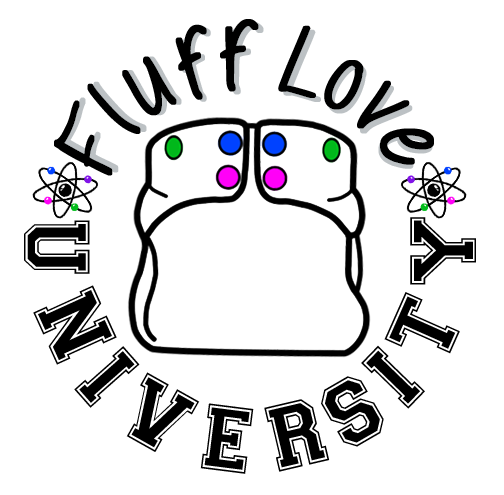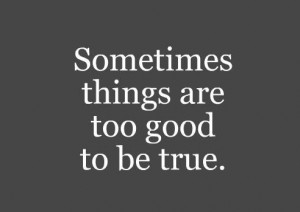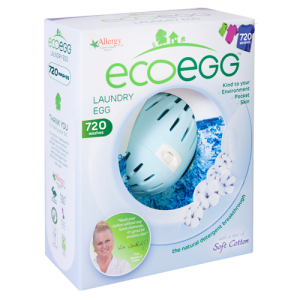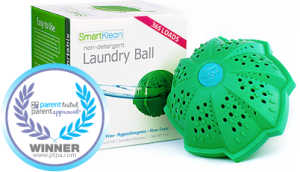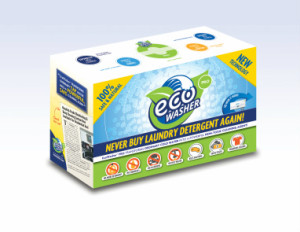Home >> Cloth Diaper Myths >> The Down Low on Detergent-less Washing Systems
For some of the products discussed below it is difficult for me to give a detailed explanation. This is due to the lack of scientific explanation given by the companies themselves. Often I found that they went on and on about how great their product is and how it does this that and the other thing along with making claims that they are “scientifically proven!” yet there was an astonishing lack of supporting evidence. The actual scientific explanations given were only partial or flat out didn’t make sense. The “scientific proof” was missing from the websites all together. *If* any scientific testing has been done on these products they haven’t been disclosed and the results aren’t available to the public or to the regulating agencies (such as the FTC or EPA). With all of that being said, I’ve addressed what I was able to find and the burden of proof lies on the companies that are asking people to pay money for these products.
Relevant Consumer Reports articles:
Ecoegg
This system is a 100% recyclable rubber and plastic egg-shaped ball that contains pellets to be replaced approximately every 720 washes. It contains two types of pellets as described as tourmaline pellets and white mineral pellets. From the website:
Tourmaline Pellets – these weaken the adhesive forces between the dirt and fabric
White Mineral Pellets – these naturally ionize the oxygen molecules in the water which then penetrate deep into the fabric lifting away the dirt and grime.
When researching tourmaline, I cannot find any information on it’s ability to weaken “adhesive forces” so I assume that they simply believe that increasing the ph of the water with tourmaline will have this affect as I was able to find that tourmaline has been found to increase water pH. I found an article that gathered research on the subject with the Ecoegg in mind and the article confirmed that this is the Ecoegg creator’s intention. [26] This research article by Mei-Sheng Xia , Cai-Hong Hu and Hong-Mei Zhang of Zhejiang, University in China shows that tourmaline had an affect on water pH in this study. The study itself was to take water and a bacterium called Rhodopseudomonas palustris, introduce tourmaline and observe the outcome. Rhodopseudomonas palustris is not a common household bacterium. It is generally found in nature especially in marine environments and soils. It is a point of interest due to it’s metabolic properties which may be helpful in breaking down harmful organic pollutants. You can find more information by reading this research paper written by S. Achanta, Missouri University and the entry on Micro Wiki. The study found that the levels of Rhodopseudomonas palustris was reduced at the introduction of tourmaline and it stabilized pH values between 5-11 all to about 8. Generally speaking, this pH is on the low end of what we would consider an ideal environment for laundry. As a point of reference, the pH of Tide when dissolved tests at about 9-10.5. *Remember: “Because the [pH] scale is logarithmic, a change of just one unit represents a tenfold change in H+ concentration” –Science Prof Online This means that a pH of 9 is ten times as alkaline as a pH of 8 and a pH of 10 is ten times as alkaline as a pH of 9.
“We acknowledge that using tourmaline alone would not give satisfactory cleaning results.
However, the combined effect with the mineral pellets does prove more effective than with
the mineral pellets alone.”
The above statement ends the article with no further explanation regarding the white mineral pellets, what they are exactly, what they do and how they interact with the tourmaline. Since the exact mineral in the “white mineral pellets” isn’t named I cannot do further research on this product. Their website does not cite any scientific research done by their company or independently. What I can say is this: oxygen molecules no matter how ionized do not have the capability of lifting away dirt. The bond between dirt and fabrics is greater than the pull of oxygen to the surface due to the vast difference in size between oxygen molecules and dirt compounds. Therefore, using this product would yield results similar to washing with water alone. It does not have the capability of cleaning laundry and it does not address the concerns of individuals washing in hard water.
SmartKlean
From their website on how it works:
“Do you ever wonder how laundry detergent is capable of removing dirt from your clothes? The answer is simple. Detergent helps the water clean.
Through a chemical process, detergents make surfaces more susceptible to water and increase the pH levels, making it easier for water to detach the dirt from the fabrics. The downside is that most of the chemical ingredients used to achieve this are toxic to your health and the environment.*
The SmartKlean Laundry Ball uses an innovative technology designed to clean fabrics through a physical process instead. On a molecular level, the water is entirely affected by its special mineral ceramics, removing dirt and residues from clothes effectively without the need of any harsh chemicals.”
For starters, they are not correct in their explanation for how detergent works. Yes, detergents are formulated to increase the ph of the water. Yes, this creates a better cleaning environment. No, this is not the only reason detergent works, it’s not even the biggest reason detergent works. Detergents contain surfactants. These surfactants have soil loving ends (hydrophobic) and water loving ends (hydrophillic). The hydrophillic end is similar to a long tail allowing the surfactant to attach to the soil deep within the layers of fabric and also rinse cleanly by attaching to water molecules. This is the primary cleaning agent in detergents. It is also incorrect to state that the chemical ingredients in detergents are toxic to your health and the environment considering that the dose and application is what makes something toxic to your health (i.e. massive quantities of misuse such as inhalation, ingestion or injection) as well as the fact that water used for washing goes through an extensive treatment process before being introduced to the environment (the exception being rare cases where water is run off into drainage fields).
The second issue I take with this claim is that the process used by the Laundry Ball is supposedly a physical one. The process they explain further is the definition of a chemical process.
This laundry ball is filled with 4 different mineral-derived ceramic beads and two magnets. It also somehow “decreases water tension” (no explanation given).
Far Infrared Ball
Breaks the water molecules into small clusters (groups) and increases their molecular motion, penetration force and washing power. It radiates negative ions to weaken the surface tension of the water allowing the dirt to be easily removed.
I have no idea what this little ceramic ball is actually made of. Far infrared is a term used when, most commonly, astronomers discuss electromagnetic radiation. “Everything emits infrared radiation. About 10% of heat transfer in Earth-like conditions is from infrared radiation. This does not appreciably help washing since both the clothes and the washer drum are already emitting plenty. Infrared radiation does break up surface tension in water but adding a tiny plastic ball won’t add a statistically significant amount of IR.” [27] Due to the fact that it is an unknown substance I can’t speak to what it actually does or doesn’t do. It certainly isn’t giving off electromagnetic radiation without a power or heat source and even if it did I’m not sure how we’re making the leap to claiming it would do all the things listed above. My best guess is that they’re claiming this ball is responsible for the infrared radiation already being emitted by the washer, it’s agitation and the temperature of the water.
Alkali Ball
Increases the pH levels in water to the same level of detergents in order to help lift oil and dirt off fabrics.
Yes, increasing the pH levels of water creates a better environment for cleaning but you need something that is doing actual cleaning in order for it’s performance to be improved by a raised pH level… It also is not disclosed what this ceramic ball is actually made of. “alkali” is an adjective. They are using it to describe the ball and whatever it is made of.
Anti-microbial Ball
Eliminates mold and pathogenic organisms. One of the ingredients of this component is nano-structured silver (silver nitrate), which is very effective in killing and preventing bacteria and infections. Some studies suggest that bacteria do not develop resistance to nano-silver nearly as quickly as they do to silver nitrate.
Plain and simple, there is zero chance that these ceramic balls contain enough nano-structured silver to kill bacteria at a measurable level. Note that the concentration is not disclosed. This statement is also dancing very closely on the line of legality since this product is not registered with the EPA and therefore cannot claim to kill germs or bacteria.
Chlorine-removal Ball
Eliminates the chlorine compound in the water protecting the fabrics from oxidation.
How does this ball eliminate chlorine from the water? Where does the CI go? Why do you want to remove chlorine from the water in the first place? What is fabric oxidation? These are all good questions. None of them are answered by this company.
Magnets
Placed on the two opposite (inner) ends of the laundry ball, this component produces a magnetic field that reduces the size of water clusters (molecule groups) and increases dissolved oxygen. More hydroxyl (OH-) ions are created to form alkaline molecules, and reduces acidity therefore decomposing impurities and odorous bacteria.
“Water is not significantly impacted by magnetic fields of the strength you would find in a washing machine. You’d have to have a liquid helium cooled superconductor to get anything cool going on.” [27]
The “science”:
Here is a link to their website explaining how they believe their product to work: The Laundry Ball Science
To summarize, they believe that the four components above work together to physically alter the structure of water molecules allowing them to shrink to a size small enough to penetrate fabrics and remove soil. They believe that the components also increase the water’s ph and emit FIR (Far Infrared Ray). They further state that the resulting levels of hydrogen peroxide are capable of destroying mold, bacteria and unpleasant smells.
Our Take:
The most concerning claim for me, is the one regarding this products ability to kill germs and destroy mold. This product is not registered with the EPA and adequate testing has not been done on this product to warrant such a claim. This for me, sets off major alarm bells in light of the Fair Packaging and Labeling Act [28]. While this “device” can fall into a gray area, many similar products have been brought to litigation by the FTC for making similar claims (see the history detailed below). Hydrogen Peroxide itself is not even an EPA approved disinfectant for laundry regardless of concentration.
As I’ve stated above when discussing each component individually, this laundry ball does not have the capability of cleaning fabrics. Water molecules no matter the size are not capable of carrying away bacteria from within the layers of fabric. In fact, the smaller molecule size is at a greater disadvantage in light of the size of dirt compounds. As numerous studies and consumer reports have found, these products do not clean any more effectively than water alone.
What further concerns me is SmartKlean’s take on diaper laundry. The suggestion of multiple rinse cycles, using the sun or dryer to sanitize and 2-3 drops of tea tree oil for smell issues. Clean diapers should not smell, they should not need regular sanitizing due to being regularly unclean and how can I trust any of their “science” if they believe that the dryer or the sun is able to sanitize. There may be some dryers out there with registered and approved sanitize cycles but those are not yet common and it’s a very basic understanding to know that the sun does not sanitize. I wouldn’t exactly volunteer to lick a shopping cart handle that’s been out in the sun all day let alone expect it to sanitize bacteria on a multi-layer fabric diaper.
A brief history of these types of products in regards to consumer protection:
- In 1997, Amway offered a ceramic washing disk on its catalogue, but removed it after concluding that it had “no measurable impact on overall cleaning.” [1]
- In 1997 Trade-Net, sold a laundry ball product (the Blue Laundry Ball) in various US states. Trade-Net claimed that the blue liquid inside their balls was structured water “that emits a negative charge through the walls of the container into your laundry water.” “This causes the water molecule cluster to disassociate, allowing much smaller individual water molecules to penetrate into the innermost part of the fabric.” Dennis Barnum, a professor of inorganic chemistry at Portland State University, said that the liquid was just water with a blue dye and couldn’t possibly have the effect claimed by the manufacturer. Barnum also said that the claims were “gibberish” and used scientific terms in ways that sounded educated to the layman but didn’t make any real sense. The Oregonian tested the balls, and found they washed marginally better than hot water with no detergent, and worse than using detergent.[11]
- After complaints, Trade-Net’s claims were investigated by consumer protection departments in Utah, Oregon and Florida, amongst others, and the company was prohibited from making certain claims, including that “such product cleans as well as conventional laundry detergent”. Trade-Net offered a ‘new’ laundry ball product after this, but were forced to pay fines,[15] including $190,000 to Oregon’s Department of Justice, $10,000 to Utah and then in April 1999, $155,000 to the states of New York, Arizona, Arkansas, Hawaii, Idaho, Illinois, Michigan, Missouri, Nebraska, Nevada, Oklahoma and the FTC. The company disappeared shortly thereafter.[16] The Federal Trade Commission has levied fines against other companies for similar fraudulent claims.[17] However, other companies kept selling similar products over the Internet.[18]
- The judge ruling against Trade-Net, issued in April 1999, said the manufacturers failed to substantiate their claims and hadn’t informed consumers about reports showing that the claims were incorrect.[19][20]
- The Australian Consumers’ Association published a report in the April 1998 issue of its magazine Choice. It concluded that laundry balls were no better than cold water.[3]
- The U.S. Federal Trade Commission published in 1999 about laundry balls, rings and discs: “Tests show that these gadgets do little more than clean out your wallet. At best, they’re marginally better than washing clothes in hot water alone, and not as effective as washing them with laundry detergent. At worst, the products are completely useless.”[12]
- In 2000 the magazine Good Housekeeping tested several laundry balls sold in the US and concluded that “these gizmos do little more than clean out your wallet.”[18]
- In April 2009 the Italian consumer association Altroconsumo carried a small test and concluded that laundry balls didn’t wash better than plain water.[21]
- In 2009 the Spanish consumer organization OCU made a study of “ecobolas” (a type of laundry ball marketed in Spain). It compared the efficacy of the laundry ball, normal detergent, and no detergent at all. It concluded that laundry balls were no better than using just water, and it recommended that consumers simply use a minimum amount of detergent.[5]
- On November 15, 2011, the Hong Kong Consumer Council published a report on the effect of using washing liquid, washing powder and washing balls. The former two were shown to be effective in removing stains. The washing balls, on the other hand, are as effective in washing out stains as plain water.[22]
- Some organizations recommending against their use are Consumers Union,[7] International Fabricare Institute (now called Drycleaning and Laundry Institute),[7] Maytag,[7] Soap and Detergent Association[7] and Spanish OCU.[5]
- In February 2011 the Spanish National Institute of Consume (Instituto Nacional del Consumo INC) ordered 14 manufacturers to cease their deceiving advertisement after testing the wash balls and concluding that they are as effective, or even less effective, than washing with water alone.[4]
- In August 2012 the Portuguese Consumer Rights Council requested a ban on the washing balls because none of the advantages advertised were proven in tests.[23]
- By making very vague claims, marketers can continue to sell laundry balls without running afoul of consumer protection laws that require veracity in advertisement.[2]
Eco Washer
How it “works”: “When you use the EcoWasher, your laundry water will first pass through the EcoWasher® before entering your washing machine. The EcoWasher® technology creates ozone, hydrogen peroxide, and negative ions within the water. This water then passes through a static mixer to create hydroxyl radicals. This oxidized water then enters your washing machine to disinfect and deep clean your laundry like never before!” [29]
In layman’s terms: “Basically, this system works by making ozone from the air and then forcing that ozone through the wash water. Ozone itself does have some nifty sanitizing properties, which is cool, but what it can’t do is replace a surfactant. Essentially, it works [similarly] to the way that oxiclean does. It is a booster. For *most* clothing, if you washed with a big scoop of oxiclean it would come out appearing pretty clean. For diapers especially, you need a surfactant to lift away the nasties – specifically the bacteria- that causes rashes and smells and burns and so on. This system relies on physically removing waste rather than any kind of chemical removal. While physical dirt removal can be fine for many things, bacteria tend to hang on to fibers and that’s what causes all the problems with diaper washing when you don’t have a good strong detergent.” – Jill B. (FLU ‘professor‘)
“It would be like trying to sanitize a counter covered in food by spraying hydrogen peroxide on top. The goal with laundry is not to sanitize, it’s to clean. The difference there is the difference between killing germs and removing them. Just like you don’t throw a pan of lasagna into the dishwasher expecting it to remove all the lasagna. You can’t use hand sanitizer on hands covered in mud, etc” – Holly R. (FLU ‘professor‘)
A conversation with our friendly neighborhood molecular biologist, Laura M. :
L: Let’s start with the big bad bacteria in the diapers. If the mechanism for which this works is that the “extra” O atom attaches to the filth in question and then that somehow carts off the filth… well there’s a problem of size when it comes to bacteria. I’ll use this analogy; imagine a mouse trying to move an elephant out of a watering hole. Yeah. Not going to happen. An O atom would likely just pass right through one of the channels in a cell wall and do… nothing. As far as dirt goes again… size matters. It’s a single atom attaching to something much larger that is likely made up of many molecules. Surfactants on the other hand are compounds, made of many many molecules and they contain a hydrophilic end to help draw the soil and dirt out of the fabric and into the water. That’s something an O atom can’t do once it’s charge is neutralized by attaching to something else.
M (member): So if the laundry water is super concentrated with ozone (the elephant version so to speak) is it plausible? If enough ozone molecules attach to the dirt in question?
L: Still not likely. Then you just have dirt with O attached to it. And ozone can help eliminate odors but it can’t remove anything. It’s just changed the molecular structure of the “dirt”compounds.
L: To explain further. You smell things because a compound of say, fecal matter travels into your nose and lands on a receptor that signals the brain that this is fecal matter. By adding enough O atoms you could alter the molecular structure of fecal matter so that it no longer attaches to the correct receptor in you nose and you smell nothing. But it’s still poop.
M: So…if the dirt was floating around in the water (not on the fabric) and several o molecules attach, then is the ‘dirt’ molecule less likely to redeposit and more likely to go down the drain?
L: Nope. There’s most likely nothing about that change in structure that would make it like the water more than the fabric. Surfactants are designed specifically to have an end that attaches to dirt and one that loves water. And that’s also assuming that several O atoms could attach to a first molecule. Only as many as would take to neutralize the charge would attach.
M: Gotcha! So…could ozone be a ‘helper’ if you will if used along with detergent?
L: It probably would only mask smell issues to be honest and it would take longer to notice an issue with your routine because of that.
One quick look at the product troubleshooting page brings a lot of concerns. It seems to be common for whites to appear dingy over time when using this product and suggests washing smaller loads or running multiple cycles if customers notice their laundry coming out not fully clean. It seems that the manufacturer has an alarming misunderstanding for what laundry detergents do and what the goal for washing laundry should be. The focus is around disinfecting laundry which is unnecessary and not the same as cleaning something. It seems the general public is already on to these types of products and it is not surprising that they rely on individual distributors much like direct-sales companies.
References:
- Adams, Cecil (1997-07-25). “Do laundry balls really work?”.The Straight Dope. p. 1. Retrieved 2008-02-25.
- Roahn H. Wynar, “Laundry Balls”, in Michael Shermer, Pat Linse, The Skeptic Encyclopedia of Pseudoscience, ABC-CLIO, pp. 130–131
- Dorothy Stein (1997-10-27). “Laundry Balls”. Faculty of Food, Clothing and Hospitality Management at Manchester Metropolitan University. Retrieved 2010-07-09.
- Sanidad frena el timo de la ‘ecobola’. El Instituto Nacional de Consumo requiere a 14 fabricantes que acaben con la publicidad engañosa de estos productos, Público, Ainhoa Iriberri, 5 February 2011, Spanish. “The Instituto Nacional del Consumo (INC) has required the manufacturers of laundry balls (…) (also called ecoballs) to cease their deceiving publicity (…) The requirement has been issued after the making (…) of a study on 14 brands of ecoballs, made to find out the most obvious: if it’s true that they are effective to wash clothes. The results of the work offer no doubts: the laundry balls do clean, yes, but the same or even less than water.”
- “Ecobola: como lavar con agua”, Compra Maestra (in Spanish) (OCU Organización de Consumidores y Usuarios) (340), September 2009,
[translation] In conclusion, the results of the Ecobola are far from those obtained with detergent. We can well attribute its “washing efficacy” to the mechanical action of the washing machine and to the temperature of the washing water… with which using this product is practically the same as washing only with water. (…) The advice of the OCU: if you want to spend less money and reduce residues, choose one of the detergents recommended in our last analysis and experiment until finding the minimal dosis that gives you good results.
- See for example: Marketers of Laundry Detergent Substitutes Charged with Making False and Unsubstantiated Claims Agree to Settlements with FTC and Eleven States and Dallas Marketers of Laundry Detergent Substitute Charged with Making False and Unsubstantiated Claims Agree to Settlement with FTC and Six States, Federal Trade Commission
- Cheryl Mendelson (2005), Laundry: the home comforts book of caring for clothes and linens (illustrated ed.), Simon and Schuster, pp. 82, 83, ISBN 9780743271455
- “More on green washing…”. grownupgreen. 2006-11-17. Archived from the original on 2007-06-23. Retrieved 2010-07-09.
- “EcoBalls — Are they for real? | Ramblings of a Geek”. Jeremy Johnstone. 2008-05-11. Retrieved 2010-07-09.
- Stephen Lower. “Magnetic water treatment pseudoscience”. Chem1.com. Retrieved 2011-01-03.
- AP (1997-05-11), “‘Miracle’ Clothes-Washing Device Investigated”, The Columbian
- FTC Consumer Alert (1 April 1999), Wash Daze: Laundry Gadgets Won’t Lighten the Load
- Michael Shermer (January 2004), “Bunkum! Broad-mindedness is a virtue when investigating extraordinary claims, but often they turn out to be pure bunk (Skeptic column)”, Scientific American: 36
- Stephen Lower, Magnetized water: pseudoscientific snake oil, Chem1.com, retrieved 2011-12-19
- “Marketers of Laundry Detergent Substitutes Charged with Making False and Unsubstantiated Claims Agree to Settlements with FTC and Eleven States”. Federal Trade Commission. April 22, 1999.
- Sources:
- “Erwin Richard Annau – Stipulated Final Judgment”. Ftc.gov. Retrieved 2010-07-09.
- Circuit court of Oregon, Marion county (12 September 1997), Case 97C14017. Assurance of voluntary compliance, Oregon Department of Justice, archived from the original on 17 December 2005
- See for example: “Dallas Marketers of Laundry Detergent Substitute Charged with Making False and Unsubstantiated Claims Agree to Settlement with FTC and Six States”. Federal Trade Commission. July 1, 1999.
- “More Dirt on Laundry Gadgets.(Brief Article)”, Good Housekeeping, 2000-01-01(registration required)
- AP (1999-03-22), “Laundry Balls Outlawed”, Skeptic (require registration)
- AP (1999-04-25), “Government Says Laundry Ball Businesses Deceptive”, The Columbian (registration required)
- “Biowashball: senza detersivo, e si vede – Altroconsumo”. Altroconsumo.it. Retrieved 2013-03-30.
- “Cleaning Power of Washing Balls No Better Than Plain Water – CHOICE # 421 (November 15, 2011)”. Hong Kong Consumer Council. 2011-11-15. Retrieved 2012-05-03.
- DECO exige retirada do mercado das “ecobolas”, ‘Diário de Notícias
- “Crystal Wash 2.0: Clean Laundry with No Detergents (January 26, 2015)”. Crystal Ball. 2015-01-26. Retrieved 2015-03-05.
- “This Kickstarter Is Clearly Just a Marketing Scam from the 90s (March 5, 2015)”. Gizmodo. 2015-03-05. Retrieved 2015-03-05.
- Eco Shopping (2015-04-22). “Tourmaline Research“
- Tyler (2015-01-25). “The (Lack Of) Science Behind Laundry Balls”. Science Badger
- Federal Trade Commission (1967). “Fair Packaging and Labeling Act”
- Eco Washer FAQ
